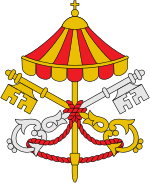Papal conclave, 1314-1316

Coat of arms during the vacancy of the Holy See
|
|
| Dates and location | |
|---|---|
| 1 May 1314 – 7 August 1316 Carpentras Cathedral, Provence; Lyon |
|
| Key officials | |
| Dean | Nicolò Albertini |
| Camerlengo | Arnaud d'Aux |
| Protopriest | Nicolas de Fréauville |
| Protodeacon | Giacomo Colonna |
| Election | |
| Vetoed | Arnaud Fournier |
| Elected Pope | |
|
Jacques Duèze Name taken: John XXII |
|
 |
|
The papal conclave from May 1, 1314, to August 7, 1316, held in the apostolic palace of Carpentras and then the Dominican house in Lyon, was one of the longest conclaves in the history of the Roman Catholic Church and the first conclave of the Avignon Papacy. The length of the conclave was due to the division of the cardinals into three factions: Italian (Orsini, Alberti, Stefaneschi, Caetani, Longhi, Fieschi, and both Colonna), Gascon (de Pellegrue, de Fougères, Nouvel, Teste, de Farges, de Garve, Daux, du Four, Raymond, and Godin), and French/Provençal (both Fredol, de Bec, Caignet de Fréauville, de Mandagot, and d'Euse).
The Italian faction wished to return the papacy to Rome, the Gascon faction—mostly composed of the relatives of the previous pope, Clement V, wished to retain the privileges and powers they had enjoyed during his rule, and the French/Provençal opposed these aims of the Italian and Gascon factions.
Among the cardinal electors there were an unusually high number of cardinal-nephews for two reasons: the previous pontiff, Clement V, had just set a record for the number of cardinal-nephews elevated by a single pontiff—soon to be surpassed by Pope Clement VI—and Clement V had reigned long enough that the only surviving Italian cardinals were those who were elevated at a younger age, who tended to be relatives of their elevator.
Had the conclave taken place according to the rules prescribed by Clement V in Ne Romani (1312) and Pope Gregory X in Ubi periculum (1274), the cardinal electors would have had to meet in the diocese where the Curia was in residence (the place where letters and apostolic causes were heard), and the local magistrates would have had the authority to compel the departing cardinals to stay. Indeed, the election did begin in that location, the episcopal palace of Carpentras (north-east of Avignon), with 23 of the 24 eligible cardinals present (Fieschi was still in Italy).
...
Wikipedia
